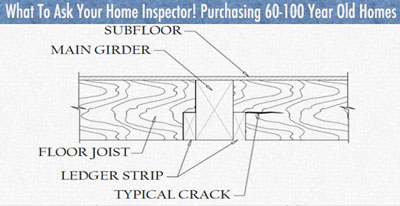
If the home you are buying is in the 60-100 year old range, there are many questions to ask your Home Inspector. New Jersey home buyers need to be aware of all potential issues resulting from construction of an older home. In this article we will discuss the importance of asking one of those questions: the importance of understanding the common “Notched/Ledger Connection” vs. the more current method a Dropped Beam or Top/Side Mount.
A common style of connecting floor joists to a main girder 60 to 100 years ago was the ledger and notch connection. In this connection, the main floor girder typically is a triple member or a square or rectangular solid single member and had a ledger strip attached to the bottom of each side. The floor joist which comes into the girder was then notched to bear on the ledger. This type of connection was very common for a period of time and is still present in many houses of the 60 to 100 year old vintage.
This connection has been replaced in modern construction with either a dropped beam for full bearing at the floor joist or either a top mount or a side mount metal connector. There is one major flaw in the design of this type of connection that has led to many performance issues in the field. The bearing of the floor joists on the notch creates tension perpendicular to the grain in the floor joists. This is the weakest type and direction of stress in wood. A crack will generally occur from the corner of the notch horizontally with the grain of the wood. In some cases, the crack will open up and pry open, dropping and rotating the bottom of the joist. All homes with these types of connections should be regularly evaluated and monitored. It is relatively easy and inexpensive to reinforce these connections prior to any cracking occurring and relatively easy and inexpensive to reinforce them when minor cracking has occurred. This can typically be accomplished by installing metal strap vertically against the wood to provide tension reinforcement and eliminate the perpendicular to the grain tension at the notch. Other solutions include sistering the girder to widen it and cutting back the beam to reconnect it with a side mount metal connector. This is a more expensive and extensive process.
The bottom line is that Home Inspectors should screen houses such as this for these connections and, whenever they are present, they should be observed by an Engineer. Potential home buyers should be aware the risks of these connections and the history of performance problems and may want to consider reinforcing the connections prior to or upon purchasing the house to prevent future issues. Homeowners with these types of connections should closely monitor them for any cracking.
